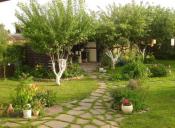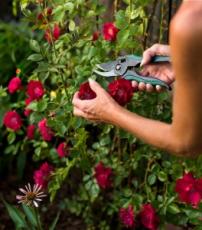Search
Login
Work in the garden. Summer pruning of decorative flowering trees and shrubs
Do you need to revive, protect and decorate your summer cottage with an original hedge, columns of bright crowns of trees and shrubs, to create almost always flowering plants? There is a way for summer pruning of decoratively flowering trees and shrubs!
Content:
- Trimming ornamental shrubs and trees: views
- Summer pruning of trees and shrubs: why video
- Summer pruning: species of ornamental trees and shrubs video video video
- Flowering decorative trees and shrubs photo
Trimming ornamental shrubs and trees: views
Any amateur gardener knows about pruning fruit plants and shrubs, because the quantity and quality of the harvest depends on its timely conduct. But, not everyone knows that ornamental trees and shrubs also require care in the form of not only top dressing, but also timely, proper pruning.
Pruning is an important element of comprehensive care for all types of fruit and ornamental trees and shrubs.
Therefore, in order to successfully carry out pruning of plants, you need to choose the right time, a quality tool (secateurs, garden shears) and answer your question: What do I want to achieve by pruning, why am I doing it ?. This question is very important, because there are several types of pruning of trees and shrubs:
- forming pruning: carried out in the spring and summer. The purpose of such pruning is the formation of the crown of trees and shrubs.
- regulatory pruning: carried out in August-September or February-April. Such pruning is carried out in order to prevent overloading, thickening of the skeletal branches forming the frame of the crown, young shoots on an already formed crown.
- anti-aging pruning: it should be done in February-April or in August-September. The purpose of this type of pruning is to rejuvenate the branches: the existing branches are trimmed, after which they begin to let out young, strong side shoots.
- sanitary pruning: carried out year-round, as needed. The purpose of this pruning is the removal of dry, dead, broken by the wind, old and diseased branches and shoots.
- recovery pruning. This type of pruning of plants consists in removing dried flowers, seedlings and fruits that are tied, which allows you to extend the flowering and active growth of the plant. It is ideal for decorative, decorative flowering trees and shrubs. Recovery pruning is carried out during the period of active growth and flowering of the plant (spring-summer).
Often, referring to the planned summer pruning of plants, it is this reduction pruning that is meant. And we’ll talk about it in more detail.
Summer pruning of trees and shrubs: why

As mentioned above, summer (regenerative pruning) of decoratively flowering trees and shrubs is a necessary condition for their full growth, flowering, which ensures their long-term decorative effect in the summer cottage.
To some extent, summer pruning of decoratively flowering trees and shrubs is
- and forming a crown: in the process of removing faded buds and inflorescences using garden scissors, you can adjust the crown shape of a decoratively flowering shrub or tree.
- and anti-aging:in the process of removing dry inflorescences, the branches are actually shortened, which stimulates the growth of lateral shoots, on which buds can be tied in the same year.
- and sanitary: dry inflorescences, especially in rainy and warm weather, can become a hotbed of many diseases characteristic of garden plants: mold, ticks. Therefore, the removal, pruning of dried flowers is an important step, not only for decorative purposes, but also for sanitary purposes.

What species of decorative flowering shrubs and trees, and to what extent is summer pruning shown?
Let's look at specific examples.
Summer pruning: species of ornamental trees and shrubs
There are many decorative flowering trees and shrubs that can be easily grown in our cottages. But, consider the most common types of ornamental plants, without which today, not a single self-respecting gardener and esthetician can do.
Lilac, shrub, reaching, in the wild, up to 7.5 m in height. But, in our gardens this is a neat plant, up to 2 m high, blooming with beautiful inflorescences.

Summer pruning of lilacs is to remove them as they dry out. In this case, the bush will not only be neat, but strong and rich in flower harvest next year.
Similarly summer pruning hydrangeas


and spirea:

dry inflorescences are removed after full flowering in late summer.
Rhododendrons: for decorative purposes, both shrubby and tree-like forms are grown.

Summer pruning of rhododendron bushes is to pinch off the green ovaries formed after flowering of bright and beautiful flowers. Tree pruning takes place in the same way in summer: on the tree-like forms of rhododendron, young ovaries are removed, plucked off. In the process of summer pruning, rejuvenation and strengthening of the plant occurs.
Roses, species, as well as forms of these plants, a lot: climbing, shrubby, tree-like.

But, summer pruning for all roses is the removal of faded buds

and wild shoots

(they are usually lighter in color: they actively grow and deplete the plant). This is done so that the plant continues to bloom for as long as possible.
Flowering Ornamental Trees and Shrubs
And this is how your garden or a garden plot might look if well-groomed, trimmed and flowering trees and shrubs in time grow in it.





















